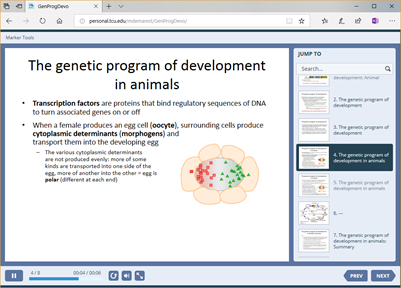Watch a brief video about the Fall 2018 TLC on this topic.
In a way, a Texas ice storm helped me change the way I teach. I was set to wrap up the final topic of the Fall 2013 semester (on human environmental impacts and ecosystem management) when the ice storm struck, closing campus for several days heading into finals week. Not wanting to leave the topic hanging unfinished, I decided to adjust the PowerPoint presentation I had prepared so that it would work well as a standalone lesson and ask the students to work through it on their own. However I knew that PowerPoint files were not a very accessible format fora good portion of my students at the time. Thus, I did the obvious thing any of us would when confronted with such a problem: I asked Google what to do, and Google told me about iSpring Suite from iSpring Solutions.

The presentation to be converted, showing the iSpring Suite ribbon tab and toolbar within PowerPoint.
Simply stated, iSpring Suite is a PowerPoint plugin that allows you to convert a PowerPoint presentation to a web presentation, seamlessly at the push of a button. You can convert just the base presentation, or add in such bells and whistles as embedded quizzes, narrations, or complex “if/then” presentation branching if you’re so inclined—all accessed from within the iSpring area of the PowerPoint toolbar ribbon. Naturally I was skeptical, but unlike so many of Google’s other software suggestions over the years it turned out that installing iSpring Suite did not indeed recruit my computer into a global spam enterprise, and instead actually did what it said it would do (and quite well): it converted my presentation to a web format with all transitions, animations, embedded videos, and other pizazz being faithfully preserved. My students were able to open the resulting lesson as a web page in whatever browser they preferred, and the semester was saved.
It was not the ability to produce a PowerPointy web page alone that ultimately proved transformative, however. It was the ability to do it so easily, with virtually no learning curve. The following semester I began to use the iSpring tool even under non-ice conditions, any time I wanted students to have the option of reviewing some sequence of slides we had gone over in class. I tend to heavily lean on visuals including animations in my presentations, and delivering the slides on the web allowed students to revisit and step through these on their own as needed. Soon I began to put presentations up not for review, but for preview—as pre-readings I assigned the students to complete prior to lecture, so that they would come to class having already picked up the basics and struggled a bit with the harder topics. In short, being able to deliver my lectures effectively outside of class paved the way to flipping my classroom.

The final product, as viewed in the Microsoft Edge browser.
For those who are unfamiliar with the flipped model of instruction, a flipped class is one in which students are tasked with learning basic content outside of class prior to lecture, so that lecture time can then be used to focus on mastery of the content—basically much of the students’ study time is pushed to before a given lecture rather than after it. In-class activities may involve such things as targeted mini-lectures, class discussion, concept checks, question and answer sessions, problem solving exercises, and other opportunities to practice applying knowledge. The thought of moving from a traditional lecture to such a model is typically daunting, especially if it means giving up a strong body of traditional lectures that took years to hone in the process: not only do we lose all that effort, but we take on the additional work of finding adequate pre-readings and new in-class activities to replace them. Because my own body of lecture work happened to exist in the form of PowerPoint files, iSpring effectively turned this around on itself: my cherished lectures simply became highly tailored pre-readings. Two birds, one stone—and without any wholesale course redesign, at least not in the “all in one go, completely overhaul the syllabus” sense. The iSpring tool allowed me to start with the spots in my course that were the easiest and made the most sense to convert, and then go from there over a period of many semesters.
Practically, publishing a web lesson to the internet is as easy as converting the source PowerPoint file and then uploading it to the internet. Here at TCU the uploading is a simple matter of dragging the output folder to your TCU network drive (specifically into a folder named wwwpub) and giving it the name you want for the lesson. Students then access the lesson by navigating to http://personal.tcu. edu/yourusername/lessonname. Because publishing is so easy I have found maintenance to be easy as well: I don’t feel reticent to update the lessons, even just to fix typos or make cosmetic adjustments.
If you’d like to browse some examples of online lessons created using iSpring Suite, feel free to visit personal.tcu.edu/mdemarest for from my own courses. These are fairly basic as far as the iSpring Suite capabilities go, using mainly just the straight conversion function sometimes with quizzes added in, all with the same visual background and layout. More highly polished demos showcasing other options and features are available at the vendor’s website. If you might find it useful to deliver dynamic content online, I highly recommend giving iSpring a try—icy weather or not.
 This article was written by Mark Demarest, Instructor in the Department of Biology for the Spring 2019 Issue of Insights.
This article was written by Mark Demarest, Instructor in the Department of Biology for the Spring 2019 Issue of Insights.